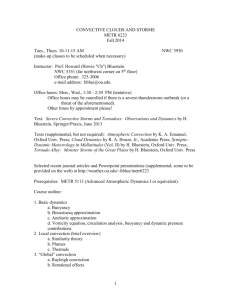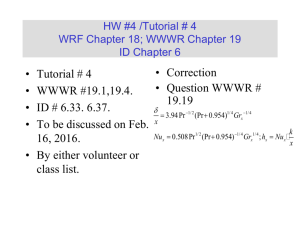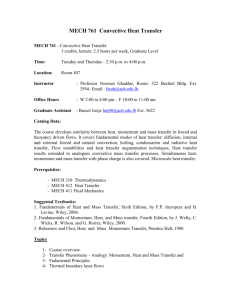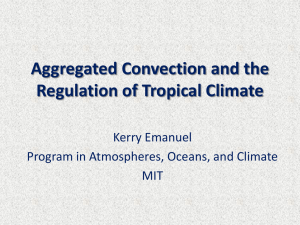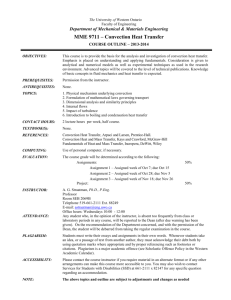Boundary layer convection
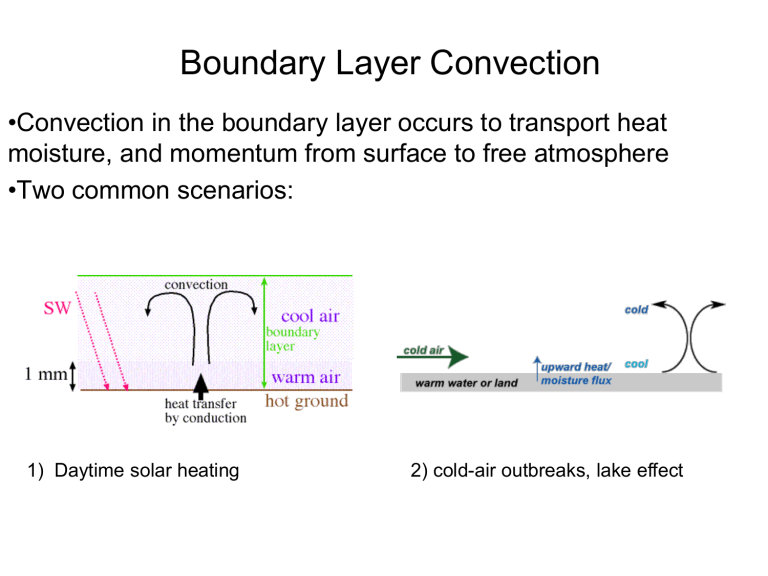
Boundary Layer Convection
•Convection in the boundary layer occurs to transport heat moisture, and momentum from surface to free atmosphere
•Two common scenarios:
1) Daytime solar heating 2) cold-air outbreaks, lake effect
•Boundary layer convection often produces clouds, but not always:
From Houze (93)
Convective Structures
1) Horizontal Convective Rolls:
–Horizontal helices oriented near parallel to the ambient flow
–Commonly seen in satellite imagery as cloud streets
From Houze (93)
Convective
Structures
1) Horizontal
Convective
Rolls:
–Also commonly observed in clear-air radar data:
HCRS
A typical aspect ratio is 3:1 but can vary from 3:1 to 10:1
Figure adapted from Houze (93)
Theory predicts an aspect ratio of
2 2 Z i
Typical updraft strengths are 1-3 ms -1 , but can be larger
Along-line Periodicities
•We often observe along-line periodicities in the cloud field that have been called
“pearls on a string”:
From Houze (93)
Along-line Periodicities
•We often observe along-line periodicities in the cloud field that have been called
“pearls on a string”:
From Wakimoto and Atkins (94, MWR)
Along-line Periodicities
•What creates the along-line periodicities?
–Two possibilities have been discussed:
•Gravity waves on top of the boundary layer
•Kelvin Helmholtz waves:
Figure adapted from Christian
(87, MWR)
The mechanism(s) is(are) still not resolved……
Convective Structures
2) Open cell convection
–Descending motion at the core
–Typical aspect ratio is 10:1
–Has a hexagonal structure
–Well observed in satellite imagery
–Generally form in weaker sheared environments than HCRs
From Houze (93)
Convective Structures
3) Closed cell convection
–ascending motion at the core
–Typical aspect ratio is 30:1
–Has a hexagonal structure
–Well observed in satellite imagery
–What conditions produce open versus closed cell convection is still not quite understood….
From Houze (93)
Why do you get a roll-like structure, anyway?
•Need a combination of buoyancy and vertical wind shear:
•Generally, HCRs from in stronger shear, moderate heat flux environments.
It is generally accepted that HCRs form in environments with some amount of convective instability (vertical heat flux at the surface) and wind shear (in the boundary layer).
•The vertical heat flux generates the convectively driven turbulence
•The wind shear organizes the convection into linear bands
However, one is not guaranteed HCRs in an environment that contains both convective instability and wind shear.
For example, open and closed cell convection tend to occur in environments that are convectively unstable and have weak wind shear.
There are two parameters that appear to be important for the formation and subsequent evolution of HCRs. They are:
•the magnitude of the sensible heat flux from the surface
•the ratio of -z i
/L where L is the Monin-Obukhov Length and z i is the boundary layer depth
So you ask, what is the Monin-Obukhov Length???? Mathematically, it is defined as: where k is the von Karman constant, g is the acceleration due to gravity.
Q: What is the physical interpretation of the numerator?
A: u’w’ and v’w’ are upward momentum fluxes by turbulence
Q: what is the physical interpretation of the denominator?
A: vertical heat flux by turbulence
•Physically, L represents the height above which convectively driven turbulence dominates over mechanically driven turbulence. It generally varies from 1-200 m (notice that this is in the surface layer).
• L becomes smaller as the vertical heat flux becomes larger during the day. Hence L is indirectly a measure of the convective instability generated by the vertical heat flux through the surface layer.
•Thus, L is only meaningful in daytime convectively driven boundary layers, specifically within the surface layer.
Let’s now examine the evolution of the ratio, -z i
/L
MID MORNING:
•Vertical heat flux is small
•Monin Obukhov Length is large
•Z i is small
•Therefore
-Z i
/L is small
MID DAY:
•Vertical heat flux is moderate
•Monin Obukhov Length is moderately large
•Z i is moderately large
•Therefore -Z i
/L is moderate
MID AFTERNOON:
Vertical heat flux is large
Monin Obukhov Length is small
Z i is large
Therefore -Z i
/L is large
Observations suggest that:
As surface heating strengthens during the mid morning hours, HCRs are the first form of boundary layer convection that is observed, and only when the vertical heat flux reaches a critical value of 35-50 Wm -2 . The value of -Z i
/L increases during the early-mid morning hours.
Close to mid day, the HCRs loose their identity and evolve into open-cellular convection. This occurs when the value of -Z i
/L exceeds a value of about 25.
Open-cellular or disorganized convection dominates for the remainder of the afternoon as
-Z i
/L continues to become larger.
From Weckwerth, 1999, MWR
Convective Structures – locations around the world
From Houze
(93)
•Notice that open cells tend to form over warmer waters – rings on cu, cb produced by heat flux from ocean
•Closed cells tend to be found over colder water – possibly suggests radiated cooling of cloud top produces this structure
Convective Structures – Diurnal Variation
•Notice that you initially get HCRS that transition into open cells
From
Weckwerth et al. (99, MWR)
Convective Structures – Thermodynamic variability in the BL
Boundary layer convection can create temperature and moisture variability within the boundary layer:
From
Weckwerth et al. (96, MWR)
Convective Structures – Thermodynamic variability in the BL
Thermodynamic variability produced by BL convection can impact sounding parameters and therefore, one’s forecast
From
Weckwerth et al. (96, MWR)
